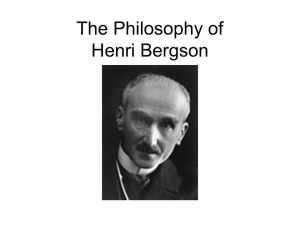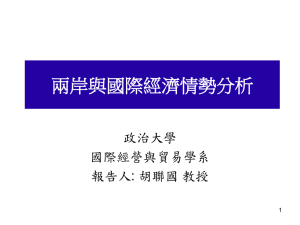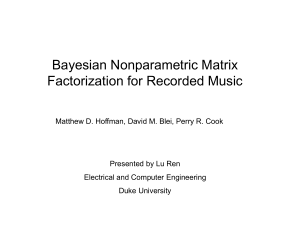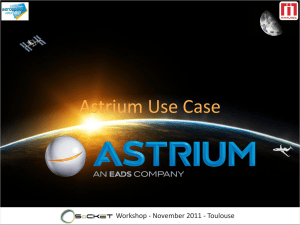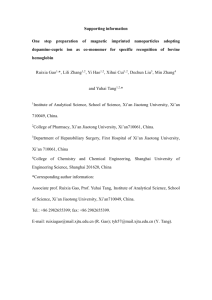CHM 4412 Chapter 14 - University of Illinois at Urbana
advertisement
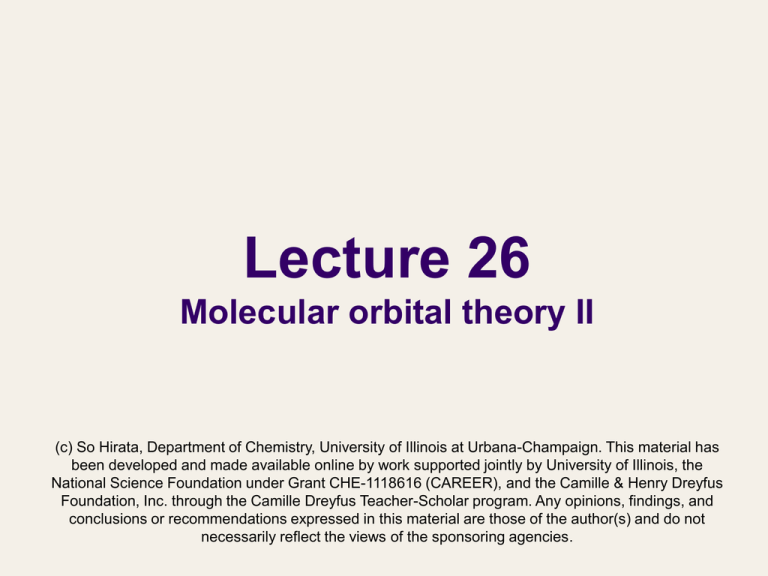
Lecture 26
Molecular orbital theory II
(c) So Hirata, Department of Chemistry, University of Illinois at Urbana-Champaign. This material has
been developed and made available online by work supported jointly by University of Illinois, the
National Science Foundation under Grant CHE-1118616 (CAREER), and the Camille & Henry Dreyfus
Foundation, Inc. through the Camille Dreyfus Teacher-Scholar program. Any opinions, findings, and
conclusions or recommendations expressed in this material are those of the author(s) and do not
necessarily reflect the views of the sponsoring agencies.
Numerical aspects of MO theory
We learn and carry out a mathematical
procedure to determine the MO coefficients,
which is based on variational theorem,
Lagrange’s undetermined multiplier
method, and matrix eigenvalue equation.
These are mathematical concepts of
fundamental importance and their use and
benefit go far beyond quantum chemistry.
What is the best wave function?
We have not discussed how to determine the
expansion coefficients of LCAO MO’s (except
when they are determined by symmetry).
Y = c A A + cB B
To find the “best” LCAO MO’s with optimized
coefficients, we must have a mathematical
criterion by which to identify the “best”
approximate wave function for a given
Hamiltonian.
Variational theorem
A general mathematical technique applicable
to many problems of chemistry, physics, and
mathematics (an important tool for manybody problems complementary to
perturbation theory).
We learn its application to quantum
mechanics.
Question: we have N normalized wave
functions that may or may not be the
eigenfunctions of the Hamiltonian H. What is
the best wave function for the ground state?
Variational theorem
Answer: evaluate the
expectation values of
energy:
ˆ
E X = ò Y HY
dt
X
*
X
and pick the one with the
lowest expectation value.
That is the best wave
function. Why?
ΨA
ΨB
ΨD
ΨC
Variational theorem
Any wave function can be expanded (exactly)
as a linear combination of eigenfunctions of H
(completeness).
Y X = c0F0 + c1F1 + c2F2 +…
Orthonormality
True ground state WF
Ground state energy
ˆ
E X = ò Y HY
dt = c0 E0 + c1 E1 + c2 E2 +…
X
2
*
X
2
2
2
2
2
³ c0 E0 + c1 E0 + c2 E0 +… = E0
Normalization
Variational theorem
The closer the wave function is to the true
ground-state one (which is measured by how
close c0 is to unity), the lower the energy
gets. Equality holds when and only when the
wave function is the true wave function.
2
2
2
* ˆ
E X = ò Y X HY X dt = c0 E0 + c1 E1 + c2 E2 +… ³ E0
We can vary (hence the name variational
theorem) a wave function’s shape (while
maintaining normalization) to minimize its
energy expectation value to systematically
improve the approximation.
Variational determination of MO’s
The MO is a linear combination of two AO’s:
Y = c A A + cB B
We find coefficients that minimize the energy
(assuming real orbitals and coefficients),
ˆ dt = c2 AHAd
ˆ t + c2 BHB
ˆ dt + 2c c AHB
ˆ dt
E = ò Y* HY
Aò
Bò
A Bò
Under the normalization condition.
1 = ò Y Y dt = c
*
2
A
òA
2
dt + c
2
B
òB
2
dt + 2cAcB ò AB dt
Minimization
At a minimum of a function, its first derivative
(gradient) must be zero (a necessary but not
a sufficient condition).
ˆ t + c2 BHB
ˆ dt + 2c c AHB
ˆ dt ù
Minimize éë E = c 2A ò AHAd
Bò
A Bò
û
¯
E
E
0;
0
cA
cB
Constrained minimization
Question: How can we incorporate this
constraint during minimization (without it, E is
not bounded from below and a minimum
does not exist)?
1 = ò Y Y dt = c
*
2
A
òA
2
dt + c
2
B
òB
2
dt + 2cAcB ò AB dt
Answer: Lagrange’s undetermined
multiplier method.
Lagrange’s undetermined
multiplier method
We need to minimize E by varying cA and cB,
E
E
0;
0
cA
cB
With the constraint that the wave function
remains normalized,
1 = ò Y Y dt = c
*
2
A
òA
2
dt + c
2
B
òB
2
dt + 2cAcB ò AB dt
Step 1: We write the constraint into a “... = 0”
form:
Y*Y dt -1 = 0
ò
Lagrange’s undetermined
multiplier method
Step 2: We define a new quantity
L(Lagrangian) to minimize, where we also
introduce an additional parameter λ
(undetermined multiplier)
*
L = E - l ò Y Y dt -1
Step 3: Minimize L by varying cA and cB as
well as λ with no constraint:
(
)
¶L
¶L
¶L
= 0;
= 0;
=0
¶c A
¶cB
¶l
Lagrange’s undetermined
multiplier method
¶L
¶L
¶L
= 0;
= 0;
=0
¶c A
¶cB
¶l
{
¶ E-l
{
¶ E-l
(
)} = 0
*
ò Y Y dt -1
¶c A
{
¶ E-l
( ò Y Y dt -1)} = 0
*
¶cB
( ò Y Y dt -1)} = 1*
¶l
ò Y Y dt = 0
*
The 3rd equation reduces to the
constraint, which we must satisfy
Once the 3rd equation (constraint) is
satisfied, the 1st and 2nd equations reduce to
minimization of E by varying cA and cB.
Minimization of E wrt two parameters with one constraint is
equivalent to minimization of L wrt three parameters
Lagrange’s undetermined multiplier
as a buy-one-get-one-free
Please minimize
this function.
Wait … let me add
this constraint.
Don’t worry – I
only added zero.
The first equation
{
¶ E-l
(
)} = 0
*
Y
ò Y dt -1
¶c A
ˆ dt = c2 AHAd
ˆ t + c2 BHB
ˆ dt + 2c c AHB
ˆ dt
E = ò Y* HY
Aò
Bò
A Bò
1 = ò Y Y dt = c
*
2
A
òA
2
dt + c
2
B
òB
(
2
dt + 2cAcB ò AB dt
2
ˆ
ˆ
0 = 2cA ò AHAdt + 2cB ò AHB dt - l 2c A ò A dt + 2cB ò AB dt
)
The second equation
{
¶ E-l
(
)} = 0
*
Y
ò Y dt -1
¶cB
ˆ dt = c2 AHAd
ˆ t + c2 BHB
ˆ dt + 2c c AHB
ˆ dt
E = ò Y* HY
Aò
Bò
A Bò
1 = ò Y Y dt = c
*
2
A
òA
2
dt + c
2
B
òB
(
2
dt + 2cAcB ò AB dt
2
ˆ
ˆ
0 = 2cB ò BHB dt + 2cA ò AHB dt - l 2cB ò B dt + 2cA ò AB dt
)
Matrix eigenvalue equation
(
)
ˆ d t + c AHB
c ò BHB
ò ˆ dt = l ( c ò B dt + c ò AB dt )
¶L
=0
¶c A
2
ˆ
ˆ
c A ò AHAd t + cB ò AHB d t = l c A ò A d t + cB ò AB d t
2
¶L
=0
¶cB
B
æ
ç
ç
è
ˆ t
ò AHAd
ˆ dt
ò AHB
A
B
ˆ dt ö æ c
A
HB
ò
֍ A
ˆ dt ÷ çè cB
ò BHB
ø
æ
ö
ç
÷ = lç
÷ø
çè
ò
ò AB dt
or
Coulomb integral
Resonance integral
(negative)
æ a
b
A
ç
çè b a B
öæ c
֍ A
÷ø çè cB
ö
æ 1
÷ = lç
÷ø
è S
or
Hc = lSc
2
A dt
A
ö
æ
AB
d
t
ò
÷ cA
÷ çç c
2
ò B dt ÷ø è B
Overlap integral
æ
S ö ç cA
÷
1 ø çè cB
ö
÷
÷ø
ö
÷
÷ø
Matrix eigenvalue equation
Use approximation S = 0 to simplify
1 S cA 1 0 cA cA
S 1 cB 0 1 cB cB
This matrix corresponds to 1 in arithmetic: a unit matrix
A cA
cA
B cB
cB
Matrix acts on a vector and returns the same vector, apart
from a constant factor λ
Matrix eigenvalue equation
Operator eigenvalue equation
ˆ
H E
Hamiltonian
operator or
matrix
eigenfunction
eigenvector
eigenvalue
A cA
cA
B cB
cB
Matrix eigenvalue equation
What is λ?
This correspondence suggests that λ
(undetermined) actually represents energy!
(
)
ˆ d t + c AHB
c ò BHB
ò ˆ dt = l ( c ò B dt + c ò AB dt )
2
ˆ
ˆ
c A ò AHAd t + cB ò AHB d t = l c A ò A d t + cB ò AB d t
+)
2
B
A
B
A
c A
c B
The left-hand side becomes
ˆ t + c2 BHB
ˆ dt + 2c c AHB
ˆ dt = E
c2A ò AHAd
Bò
A Bò
(
The right-hand side becomes
l c
2
A
òA
2
dt + c
2
B
òB
2
)
dt + 2c AcB ò AB dt = l
We find that in fact λ = E !
Lagrange’s undetermined
multiplier
Many chemistry and physics problems are
recast into constrained minimization or
maximization.
Lagrange’s method can convert them into
unconstrained minimization or maximization
with slightly increased dimension.
The undetermined multiplier ends up in
representing an important physical quantity.
Matrix eigenvalue equation
How do we solve this equation?
A cA
1
E
S
B cB
S cA
1 cB
Observation: two equations for three
unknowns (cA, cB, and E) – indeterminate?
The indeterminacy is removed by the
normalization constraint.
1 = ò Y Y dt = c
*
2
A
òA
2
dt + c
2
B
òB
2
dt + 2cAcB ò AB dt
Matrix eigenvalue equation
A cA
1
E
S
B cB
S cA
1 cB
A E ES c A 0
ES B E cB 0
If this matrix has an inverse, we invariably obtain a
trivial, nonphysical solution:
cA A E
cB ES
1
ES 0
B E 0
Inverse matrix
a b e
c
d
g
f ae bg af bh
h ce dg cf dh
1
Definition
of inverse
a b a b 1 0
Unit matrix
c d c d 0 1
1
a b
1 d b
c
d
c
a
ad
bc
We have verified that this is indeed the inverse
Inverse matrix
1
a b
1 d b
c
d
c
a
ad
bc
determinant
If the determinant is zero, the inverse does not exist
Inverse matrix
A E ES c A 0
ES B E cB 0
Determinant is nonzero
æ c
ç A
çè cB
ö
÷
÷ø
ì
ï
ï
ï
=í
ï
ï
ïî
æ a - E b - ES
A
ç
çè b - ES a B - E
-1
ö æ
0 ö æ 0 ö
÷ ç
=ç
÷
÷ø è 0 ø è 0 ÷ø
trivial
nonphysical
solution
or
physical
(a A - E)(a B - E) - ( b - ES)( b - ES) = 0 solution
Determinant is zero
Summary
Variational theorem gives us a way to identify the best
approximate wave function for the ground state; it is the
one with the lowest energy expectation value.
Variational theorem therefore leads to minimization of
expectation value with the constraint that the wave
function is normalized.
Constrained minimization can be converted to
unconstrained minimization with slightly higher
dimension by Lagrange’s undetermined multiplier
method.
With these, optimization of LCAO MO’s becomes a
matrix eigenvalue equation.
